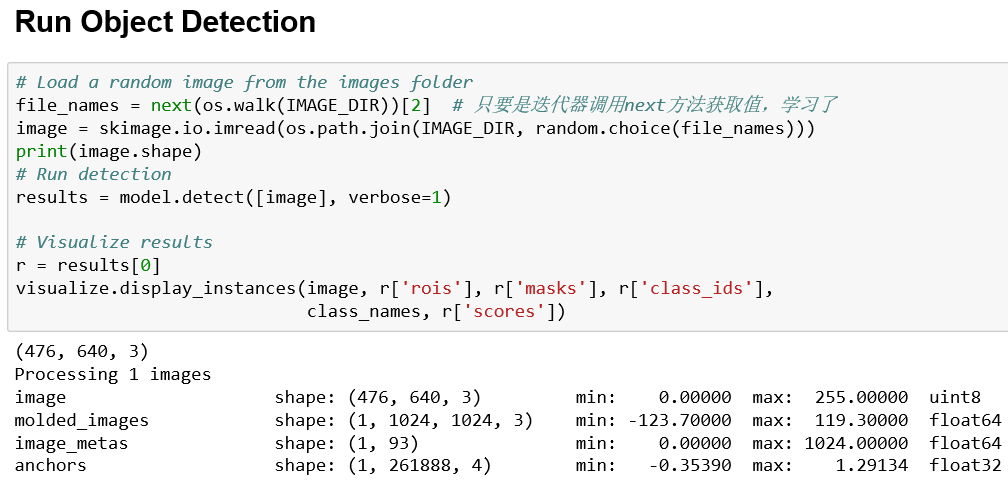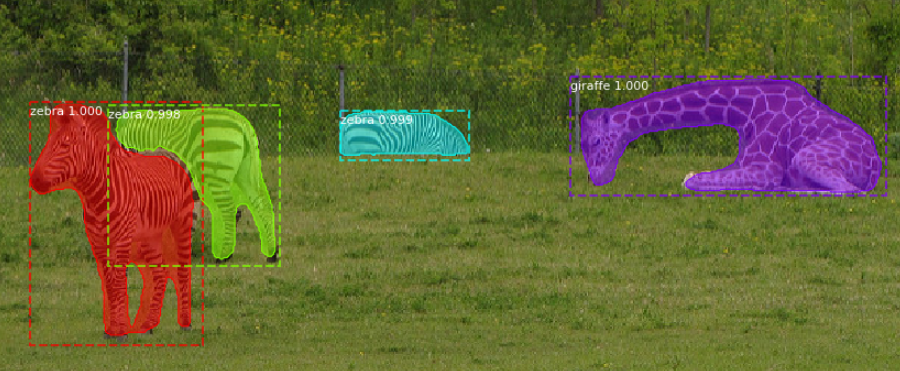『计算机视觉』Mask-RCNN_推断网络终篇:使用detect方法进行推断
一、detect和build
前面多节中我们花了大量笔墨介绍build方法的inference分支,这节我们看看它是如何被调用的。
在dimo.ipynb中,涉及model的操作我们简单进行一下汇总,首先创建图并载入预训练权重,

然后规范了类别序列,

实际开始检测的代码块如下,


经由model.detect方法,调用model.build方法(也就是我们前面多节在讲解的方法)构建图,实施预测。
二、detect方法
首先看看detect方法的前几行(和build一样,同见model.py),
def detect(self, images, verbose=0):
"""Runs the detection pipeline. images: List of images, potentially of different sizes. Returns a list of dicts, one dict per image. The dict contains:
rois: [N, (y1, x1, y2, x2)] detection bounding boxes
class_ids: [N] int class IDs
scores: [N] float probability scores for the class IDs
masks: [H, W, N] instance binary masks
"""
assert self.mode == "inference", "Create model in inference mode."
assert len(
images) == self.config.BATCH_SIZE, "len(images) must be equal to BATCH_SIZE" # 日志记录
if verbose:
log("Processing {} images".format(len(images)))
for image in images:
log("image", image)
1、待检测图像预处理
# Mold inputs to format expected by the neural network
molded_images, image_metas, windows = self.mold_inputs(images) # Validate image sizes
# All images in a batch MUST be of the same size
image_shape = molded_images[0].shape
for g in molded_images[1:]:
assert g.shape == image_shape,\
"After resizing, all images must have the same size. Check IMAGE_RESIZE_MODE and image sizes."
简单的纠错和日志控制之后,即调用mold_input函数对输入图片进行调整,并记录图片信息。
self.mold_inputs方法如下,
def mold_inputs(self, images):
"""Takes a list of images and modifies them to the format expected
as an input to the neural network.
images: List of image matrices [height,width,depth]. Images can have
different sizes. Returns 3 Numpy matrices:
molded_images: [N, h, w, 3]. Images resized and normalized.
image_metas: [N, length of meta data]. Details about each image.
windows: [N, (y1, x1, y2, x2)]. The portion of the image that has the
original image (padding excluded).
"""
molded_images = []
image_metas = []
windows = []
for image in images:
# Resize image
# TODO: move resizing to mold_image()
molded_image, window, scale, padding, crop = utils.resize_image(
image,
min_dim=self.config.IMAGE_MIN_DIM, # 800
min_scale=self.config.IMAGE_MIN_SCALE, # 0
max_dim=self.config.IMAGE_MAX_DIM, # 1024
mode=self.config.IMAGE_RESIZE_MODE) # square
molded_image = mold_image(molded_image, self.config) # 减平均像素
# Build image_meta 形式为np数组
image_meta = compose_image_meta(
0, image.shape, molded_image.shape, window, scale,
np.zeros([self.config.NUM_CLASSES], dtype=np.int32))
# Append
molded_images.append(molded_image)
windows.append(window)
image_metas.append(image_meta)
# Pack into arrays
molded_images = np.stack(molded_images)
image_metas = np.stack(image_metas)
windows = np.stack(windows)
return molded_images, image_metas, windows
utils.resize_image函数用于缩放原图像,它生成一个scale,返回图像大小等于输入图像大小*scale并保证
- 最短边等于输入min_dim,最长边不大于max_dim
- 如果最长边超过了max_dim则保证最长边等于max_dim,最短边不再限制
最后,将图片padding到max_dim*max_dim大小(即molded_images大小其实是固定的),其返回值如下:
image.astype(image_dtype), window, scale, padding, crop
表示:resize后图片,原图相对resize后图片的位置信息(详见『计算机视觉』Mask-RCNN_推断网络其五:目标检测结果精炼),放缩倍数,padding信息(四个整数),crop信息(四个整数或者None)。
mold_image函数更为简单,就是把图片像素减去了个平均值,MEAN_PIXEL=[123.7 116.8 103.9]。
compose_image_meta记录了全部的原始信息,可以看到,crop并未收录在内,
def compose_image_meta(image_id, original_image_shape, image_shape,
window, scale, active_class_ids):
"""Takes attributes of an image and puts them in one 1D array. image_id: An int ID of the image. Useful for debugging.
original_image_shape: [H, W, C] before resizing or padding.
image_shape: [H, W, C] after resizing and padding
window: (y1, x1, y2, x2) in pixels. The area of the image where the real
image is (excluding the padding)
scale: The scaling factor applied to the original image (float32)
active_class_ids: List of class_ids available in the dataset from which
the image came. Useful if training on images from multiple datasets
where not all classes are present in all datasets.
"""
meta = np.array(
[image_id] + # size=1
list(original_image_shape) + # size=3
list(image_shape) + # size=3
list(window) + # size=4 (y1, x1, y2, x2) in image cooredinates
[scale] + # size=1
list(active_class_ids) # size=num_classes
)
return meta
最后拼接返回。
2、anchors生成
首先调用方法get_anchors生成锚框(见『计算机视觉』Mask-RCNN_锚框生成),shape为[anchor_count, (y1, x1, y2, x2)],
# Anchors
anchors = self.get_anchors(image_shape)
# Duplicate across the batch dimension because Keras requires it
# TODO: can this be optimized to avoid duplicating the anchors?
# [anchor_count, (y1, x1, y2, x2)] --> [batch, anchor_count, (y1, x1, y2, x2)]
anchors = np.broadcast_to(anchors, (self.config.BATCH_SIZE,) + anchors.shape)
然后为之添加batch维度,最终[batch, anchor_count, (y1, x1, y2, x2)]。
3、inference网络预测
调用keras的predict方法前向传播,在预测任务中我们仅仅关注detections和mrcnn_mask两个输出。
# Run object detection
# 于__init__中定义:self.keras_model = self.build(mode=mode, config=config)
# 返回list: [detections, mrcnn_class, mrcnn_bbox,
# mrcnn_mask, rpn_rois, rpn_class, rpn_bbox]
# detections, [batch, num_detections, (y1, x1, y2, x2, class_id, score)]
# mrcnn_mask, [batch, num_detections, MASK_POOL_SIZE, MASK_POOL_SIZE, NUM_CLASSES]
detections, _, _, mrcnn_mask, _, _, _ =\
self.keras_model.predict([molded_images, image_metas, anchors], verbose=0)
4、坐标框重映射
我们对于坐标的操作都是基于输入图片的相对位置,且单位长度也是其宽高,在最后我们需要将之修正回像素空间坐标。
令输入图片list不需要输入图片具有相同的尺寸,所以我们在恢复时必须注意单张处理之。
# Process detections
results = []
for i, image in enumerate(images):
# 需要单张处理,因为原始图片images不保证每张尺寸一致
final_rois, final_class_ids, final_scores, final_masks =\
self.unmold_detections(detections[i], mrcnn_mask[i],
image.shape, molded_images[i].shape,
windows[i])
目标检测框重映射:unmold_detections函数
def unmold_detections(self, detections, mrcnn_mask, original_image_shape,
image_shape, window):
"""Reformats the detections of one image from the format of the neural
network output to a format suitable for use in the rest of the
application. detections: [N, (y1, x1, y2, x2, class_id, score)] in normalized coordinates
mrcnn_mask: [N, height, width, num_classes]
original_image_shape: [H, W, C] Original image shape before resizing
image_shape: [H, W, C] Shape of the image after resizing and padding
window: [y1, x1, y2, x2] Pixel coordinates of box in the image where the real
image is excluding the padding. Returns:
boxes: [N, (y1, x1, y2, x2)] Bounding boxes in pixels
class_ids: [N] Integer class IDs for each bounding box
scores: [N] Float probability scores of the class_id
masks: [height, width, num_instances] Instance masks
"""
# How many detections do we have?
# Detections array is padded with zeros. Find the first class_id == 0.
zero_ix = np.where(detections[:, 4] == 0)[0] # DetectionLayer 末尾对结果进行了全0填充
N = zero_ix[0] if zero_ix.shape[0] > 0 else detections.shape[0] # 有意义的检测结果数N # Extract boxes, class_ids, scores, and class-specific masks
boxes = detections[:N, :4] # [N, (y1, x1, y2, x2)]
class_ids = detections[:N, 4].astype(np.int32) # [N, class_id]
scores = detections[:N, 5] # [N, score]
masks = mrcnn_mask[np.arange(N), :, :, class_ids] # [N, height, width, num_classes] # Translate normalized coordinates in the resized image to pixel
# coordinates in the original image before resizing
window = utils.norm_boxes(window, image_shape[:2]) # window相对输入图片规范化 wy1, wx1, wy2, wx2 = window
shift = np.array([wy1, wx1, wy1, wx1])
wh = wy2 - wy1 # window height
ww = wx2 - wx1 # window width
scale = np.array([wh, ww, wh, ww])
# Convert boxes to normalized coordinates on the window
boxes = np.divide(boxes - shift, scale) # box相对window坐标规范化
# Convert boxes to pixel coordinates on the original image
boxes = utils.denorm_boxes(boxes, original_image_shape[:2]) # box相对原图解规范化 # Filter out detections with zero area. Happens in early training when
# network weights are still random
exclude_ix = np.where(
(boxes[:, 2] - boxes[:, 0]) * (boxes[:, 3] - boxes[:, 1]) <= 0)[0]
if exclude_ix.shape[0] > 0:
boxes = np.delete(boxes, exclude_ix, axis=0)
class_ids = np.delete(class_ids, exclude_ix, axis=0)
scores = np.delete(scores, exclude_ix, axis=0)
masks = np.delete(masks, exclude_ix, axis=0)
N = class_ids.shape[0] # Resize masks to original image size and set boundary threshold.
full_masks = []
for i in range(N): # 单个box操作
# Convert neural network mask to full size mask
full_mask = utils.unmold_mask(masks[i], boxes[i], original_image_shape)
full_masks.append(full_mask)
full_masks = np.stack(full_masks, axis=-1)\
if full_masks else np.empty(original_image_shape[:2] + (0,)) # [n, (y1, x1, y2, x2)]
# [n, class_id]
# [n, class_id]
# [h, w, n]
return boxes, class_ids, scores, full_masks
为了将输出结果格式还原,我们需要进行如下几步:
剔除为了凑齐DETECTION_MAX_INSTANCES 填充的全0检测结果
将box放缩回原始图片对应尺寸
剔除面积为0的box
mask输出尺寸还原
在网络中操作的box尺寸为基于输入图片的规范化坐标,window为像素坐标,所以我们先将window相对输入图片规范化,使得window和box处于同一坐标系,然后这两者坐标就可以直接交互了,使box相对window规范化,此时box坐标尺寸都是window的相对值,而window和原始图片是直接有映射关系的,所以box遵循其关系,映射回原始像素大小即可。
完成box映射后,我们开始对mask进行处理。
Mask信息重映射:utils.unmold_mask函数
utils.unmold_mask受调用于unmold_detections尾部:
# Resize masks to original image size and set boundary threshold.
full_masks = []
for i in range(N): # 单个box操作
# Convert neural network mask to full size mask
full_mask = utils.unmold_mask(masks[i], boxes[i], original_image_shape)
full_masks.append(full_mask)
full_masks = np.stack(full_masks, axis=-1)\
if full_masks else np.empty(original_image_shape[:2] + (0,))
首先重申我们的unmold_detections函数是对单张图片进行处理的,而mask处理进一步的是对每一个检测框进行处理的,
def unmold_mask(mask, bbox, image_shape):
"""Converts a mask generated by the neural network to a format similar
to its original shape.
mask: [height, width] of type float. A small, typically 28x28 mask.
bbox: [y1, x1, y2, x2]. The box to fit the mask in. Returns a binary mask with the same size as the original image.
"""
threshold = 0.5
y1, x1, y2, x2 = bbox
mask = resize(mask, (y2 - y1, x2 - x1))
mask = np.where(mask >= threshold, 1, 0).astype(np.bool) # Put the mask in the right location.
full_mask = np.zeros(image_shape[:2], dtype=np.bool)
full_mask[y1:y2, x1:x2] = mask
return full_mask
我们在inference中输出的mask信息仅仅是一般的生成网络输出,所以为了得到掩码格式我们需要一个阈值。明确了这个概念,下一步就简单了,我们将mask输出放缩到对应的box大小即可(此时的box已经相对原始图片进行了放缩,是像素坐标),然后将放缩后的掩码按照box相对原始图片的位置贴在一张和原始图片等大的空白图片上。
我们对每一个检测目标做这个操作,就可以得到等同于检测目标数的原始图片大小的掩码图片(每个掩码图片上有一个掩码对象),将之按照axis=-1拼接,最终获取[h, w, n]格式输出,hw为原始图片大小,n为最终检测到的目标数目。
最终,将计算结果返回,退出函数。
# [n, (y1, x1, y2, x2)]
# [n, class_id]
# [n, class_id]
# [h, w, n]
return boxes, class_ids, scores, full_masks
实际调用如下:

『计算机视觉』Mask-RCNN_推断网络终篇:使用detect方法进行推断的更多相关文章
- 『计算机视觉』经典RCNN_其二:Faster-RCNN
项目源码 一.Faster-RCNN简介 『cs231n』Faster_RCNN 『计算机视觉』Faster-RCNN学习_其一:目标检测及RCNN谱系 一篇讲的非常明白的文章:一文读懂Faster ...
- 『计算机视觉』经典RCNN_其一:从RCNN到Faster-RCNN
RCNN介绍 目标检测-RCNN系列 一文读懂Faster RCNN 一.目标检测 1.两个任务 目标检测可以拆分成两个任务:识别和定位 图像识别(classification)输入:图片输出:物体的 ...
- 『计算机视觉』Mask-RCNN_推断网络其二:基于ReNet101的FPN共享网络暨TensorFlow和Keras交互简介
零.参考资料 有关FPN的介绍见『计算机视觉』FPN特征金字塔网络. 网络构架部分代码见Mask_RCNN/mrcnn/model.py中class MaskRCNN的build方法的"in ...
- 『计算机视觉』Mask-RCNN_推断网络其四:FPN和ROIAlign的耦合
一.模块概述 上节的最后,我们进行了如下操作获取了有限的proposal, # [IMAGES_PER_GPU, num_rois, (y1, x1, y2, x2)] # IMAGES_PER_GP ...
- 『计算机视觉』Mask-RCNN_训练网络其三:训练Model
Github地址:Mask_RCNN 『计算机视觉』Mask-RCNN_论文学习 『计算机视觉』Mask-RCNN_项目文档翻译 『计算机视觉』Mask-RCNN_推断网络其一:总览 『计算机视觉』M ...
- 『计算机视觉』Mask-RCNN_训练网络其二:train网络结构&损失函数
Github地址:Mask_RCNN 『计算机视觉』Mask-RCNN_论文学习 『计算机视觉』Mask-RCNN_项目文档翻译 『计算机视觉』Mask-RCNN_推断网络其一:总览 『计算机视觉』M ...
- 『计算机视觉』Mask-RCNN_训练网络其一:数据集与Dataset类
Github地址:Mask_RCNN 『计算机视觉』Mask-RCNN_论文学习 『计算机视觉』Mask-RCNN_项目文档翻译 『计算机视觉』Mask-RCNN_推断网络其一:总览 『计算机视觉』M ...
- 『计算机视觉』Mask-RCNN_从服装关键点检测看KeyPoints分支
下图Github地址:Mask_RCNN Mask_RCNN_KeyPoints『计算机视觉』Mask-RCNN_论文学习『计算机视觉』Mask-RCNN_项目文档翻译『计算机视觉』Mas ...
- 『计算机视觉』Mask-RCNN_锚框生成
Github地址:Mask_RCNN 『计算机视觉』Mask-RCNN_论文学习 『计算机视觉』Mask-RCNN_项目文档翻译 『计算机视觉』Mask-RCNN_推断网络其一:总览 『计算机视觉』M ...
随机推荐
- 【入门】Gradle的基本使用、在IDEA中的配置、常用命令
一.介绍 java的源码构建工具,大致经历了 ant -> maven -> gradle 这个过程,每一次进步,都是在解决之前的工具所带来的问题,简单来说: 1. ant 功能虽然也很强 ...
- SpringBatch是什么?
https://segmentfault.com/a/1190000016278038 <dependency> <groupId>org.springframework.bo ...
- Unity3D代码动态修改材质球的颜色
代码动态修改材质球的颜色: gameObject.GetComponent<Renderer>().material.color=Color.red;//当材质球的Shader为标准时,可 ...
- (转载)C# winform 在一个窗体中如何设置另一个窗体的TextBox的值
方法1:修改控件的访问修饰符.(不建议使用此法) public System.Windows.Forms.TextBox textBox1; 在调用时就能直接访问 Form1 frm = new Fo ...
- 定义统一的返回格式(controller)
一:单独创建一个类来表示返回结果 package com.jk51.commons.dto; /** * Created by Administrator on 2017/6/13. */ publi ...
- Windows下使用命令安装Python的scipy库出错的解决
平时使用Python都是在Sublime下使用,不想使用IDE.使用各种库时安装也就是使用pip安装即可.来说说今天自己遇到的一个问题:使用scipy数学库时,使用命令: pip install sc ...
- pc网页中嵌入百度地图
pc网页中嵌入百度地图 1 打开百度地图生成器: http://api.map.baidu.com/lbsapi/creatmap/ 2 设置好了之后,点击获取代码,将代码粘贴到文件中保存为html文 ...
- mesh合并
[风宇冲]Unity3D性能优化:DrawCall优化 (2013-03-05 15:39:27) 转载▼ 标签: it unity unity3d unity3d教程 分类: Unity3d之优化 ...
- 蚂蚁金服×西安银行 | 西安银行手机银行App的智能升级之路
小蚂蚁说: 当前,数字化信号已经逐渐深入到社会的每个角落,影响着用户的心智和行为,来到数字化时代门口的银行,需要注意到数字化信号.西安银行通过引入蚂蚁金服移动开发平台mPaaS,对手机银行进行架构升级 ...
- SNMOJ 31
考虑将给入的$A$数组差分,得到差分数组$C$ 每一次操作相当于把差分数组的每一位${+1}$,其中一个位置上${-n+1}$. 我们可以直接算出要进行多少次操作:${T=\frac{\sum A[i ...
